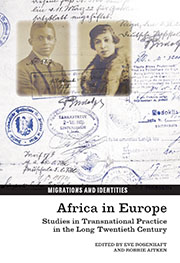Book contents
- Frontmatter
- Contents
- Acknowledgements
- List of Illustrations
- List of Abbreviations
- List of Contributors
- 1 Introduction
- I Enacting Identity: Individuals, Families and Communities
- II Authenticity and Influence: Contexts for Black Cultural Production
- III Post-colonial Belonging
- IV Narratives/Histories
- 12 Middle Passage Blackness and its Diasporic Discontents: The Case for a Post-War Epistemology
- 13 Black and German: Filming Black History and Experience
- 14 Excavating Diaspora: An Interview Discussing Elleke Boehmer's Novel Nile Baby
- 15 Afterword
- Bibliography
- Index
13 - Black and German: Filming Black History and Experience
from IV - Narratives/Histories
- Frontmatter
- Contents
- Acknowledgements
- List of Illustrations
- List of Abbreviations
- List of Contributors
- 1 Introduction
- I Enacting Identity: Individuals, Families and Communities
- II Authenticity and Influence: Contexts for Black Cultural Production
- III Post-colonial Belonging
- IV Narratives/Histories
- 12 Middle Passage Blackness and its Diasporic Discontents: The Case for a Post-War Epistemology
- 13 Black and German: Filming Black History and Experience
- 14 Excavating Diaspora: An Interview Discussing Elleke Boehmer's Novel Nile Baby
- 15 Afterword
- Bibliography
- Index
Summary
There are … critical points of deep and significant difference, which constitute ‘what we really are’, or rather – since history has intervened – ‘what we have become’.
The constant battle that the filmmaker has (and will always have) is to find the most appropriate way to reproduce an idea, a thought process or a meaning of an experience in the formal structure that we can describe as a film. As a black filmmaker seeking appropriate methods by which to represent the black subject and black history, my battle manifests itself as a search for meaning within practice methodology. For me, it is the formal structure of narrative film that contains (and constrains) the building blocks for representation in cinema, and in this chapter I will explain how I have appropriated narrative forms within my practice for a specific purpose.
Although individual artistic approaches to film practice (or the practice of filmmaking) vary with each filmmaker, conflicts become apparent if we attempt to discuss specific approaches in formulating a piece of work. For example, the British filmmaker Alexander Mackendrick posits filmmaking as a craft, with outcomes that result in ‘nothing more than a series of visual conventions based on the contract that exists between filmmaker and audience’. In contrast, the French filmmaker Robert Bresson recognised that the cinematic process is inextricably linked with – though separate from – other pure art forms such as photography, sculpture and theatre.
- Type
- Chapter
- Information
- Africa in EuropeStudies in Transnational Practice in the Long Twentieth Century, pp. 234 - 247Publisher: Liverpool University PressPrint publication year: 2013



